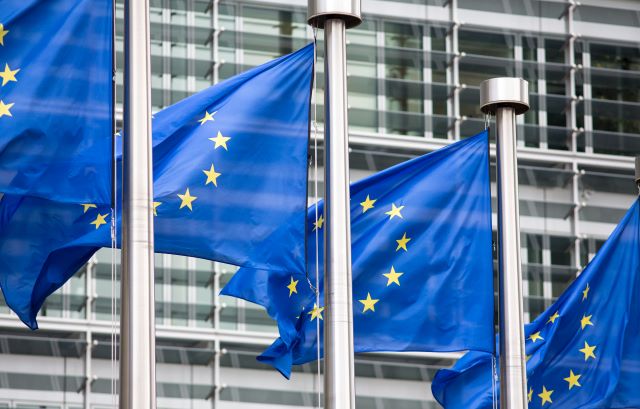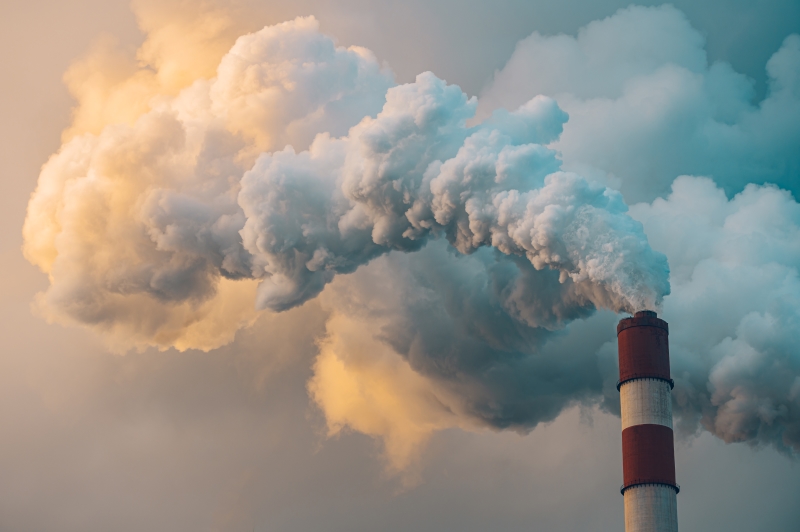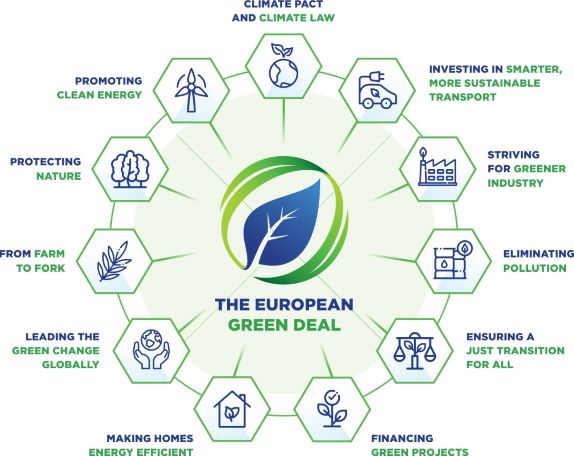European Green Deal – What’s New and Coming for 2022

Striving to be the world’s first climate-neutral continent, this has been realized as a start of the Commission’s vision since 2019. Members of The European countries presented on December 11, 2019, the overarching objective of the EU Green Deal is for the EU members to become the first climate neutral continent by 2050 resulting in cleaner environment, more affordable energy, smarter transport, new employment creation, and overall better quality of life.
According to the Commission, there are reasons pushing for the plans into actions led by EU country members which they are based upon the hot environmental issues and catastrophic happenings - such as climate change, a loss of biodiversity, ozone depletion, water pollution, urban stress, waste production and more

2022 - Initiatives of making sustainable products the norm…
In 2022, the Commission is proposing new rules to make almost all physical goods and commodities of the EU markets and what will import from other countries to be more friendly to the environment, circular and energy efficient throughout the whole product lifecycle from the design stage through to daily use of products by consumers including how to re-purposing and make them end-of-life with a process that is friendly to environments and is also non-hazardous to humans.
A proposal of the Commission was presented for a new Regulation on Eco-design for Sustainable Products addresses the product design which determines up to 80% of a product's lifecycle environmental impacts. A regulation sets new requirements to make products more durable, reliable, reusable, upgradable, reparable, easier to maintain, refurbish and recycle, and energy and resource efficient for consumers in EU country members. Together with this proposal, the Commission has also recently adopted an Eco-design and Energy Labelling Working Plan 2022-2024 to cover new energy-related products, update and increase the ambition for products that are already regulated, as a transitionary measure until the new regulation enters into force. It notably addresses the action and priority to tackle on consumer electronics (i.e., smart phones, tablets and solar panels) as they are the fastest growing waste stream.
To support the deployment of sustainable products across the EU markets, targeted sectoral initiatives are also presented in 2022. The EU Strategy for Sustainable and Circular Textiles and the revision of the Construction Products Regulation will address two priority product groups with significant impacts. EU records cited that European consumption of textiles has the fourth highest impact on the environment and climate change after food, housing and mobility. It is also the third highest area of consumption for water and land use, and the fifth highest for the usage of primary raw materials.
With today's proposals as presented the Commission, it demonstrates an ambition of the Commission that the tools to move to a truly circular economy in the EU is potentially achievable and beneficial for all. The proposals build on the success of EU's existing Eco-design rules, which have brought re-markable reductions in EU's energy consumption and turned to be significant savings for consumers.
Today's proposal in 2022 of EU Green Deal which is important to the preparedness of industries and manufacturers extends the existing Eco-design framework in two ways –
(1) To cover the broadest possible range of products; and
(2) To broaden the scope of the requirements with which products are to comply.
In the proposal, it sets criteria not only for energy efficiency, but also for circularity and an overall reduction of the environmental and climate footprint of products that will lead to more energy and resource independence and less pollution. This becomes a pass and pre-requisite of any products to be sold, imported and used in EU country members which any industries targets EU market should be complied on new regulations.
The new proposal expects to strengthen the Single Market policy for EU, avoiding diverging legislation in each country member, and create economic opportunities for innovation and job creation, notably in remanufacturing, maintenance, recycling and repair. (Although all EU leaders signed off on the European green deal in December 2019, disagreements regarding the goals and their timeline to achieve each factor arose. Poland together with Czech Republic, Bulgaria and Romania have stated that climate neutrality by 2050 will not be a possibility for their country due to their reliance on coal as their main power source, potential job loss, economic stagnation and political unrest). The proposal will set a framework and a process which the Commission will be working in close cooperation with all those concerned for progressively setting out requirements for each product (or group of products) that is compliant.
In 2021, according to a report from EU, the existing Eco-design requirements on products imported, made, and consumed in EU country members saved the consumers €120 Billion. The rules on designs that are harmless to an environment have also led to a 10% lower annual energy consumption by the products circulated in Europe.
By 2030, the new framework takes an aim leading to 132 Mtoe of primary energy savings (Mtoe is an acronym that stands for million or mega tonnes of oil equivalent. The unit quantifies the amount of energy released when burning one mega tonne of crude oil - The respective Mtoe value of different fuels varies). This saving corresponds roughly to 150 bcm (billion cubic meters) of natural gas, almost equivalent to EU's imports of Russian gas.
The Commission is also presenting this year a new strategy to make textiles more durable, repairable, reusable and recyclable. This approach that becomes a regulation is imposing to tackle fast fashion, textile waste and the destruction of unsold textiles, and ensure the textile production takes place anywhere in the world in full respect of social responsibility, fair wage, gender equality and human right.
The EU Strategy for Sustainable and Circular Textiles sets out the vision and concrete actions to ensure that by 2030 textile products placed and sold on the EU market are long-lived and recyclable, made as much as possible of recycled fibers, free of hazardous substances and produced in respect of social rights and the environment. Consumers will benefit longer from high quality textiles, fast fashion should be out of fashion, and economically profitable re-use and repair services should be widely available. In a competitive, resilient and innovative textiles sector, manufacturers have to take responsibility for their products along the value chain, including when they become waste. In this way, the circular textiles ecosystem will be thriving, and be driven by sufficient capacities for innovative fiber-to-fiber recycling, while the incineration and landfilling of textiles must be reduced to the minimum.
The specific measures will include Eco-design requirements for textiles, clearer information, a Digital Product Passport and a mandatory EU extended producer responsibility scheme. It also foresees the measures to tackle the unintentional release of microplastics from textiles, ensure the accuracy of green claims, and boost circular business models, including reuse and repair services. To address fast fashion, the strategy also calls on fashion companies to reduce the number of collections per year, take responsibility and act to minimize their carbon and environmental footprints, and on Member countries of EU to adopt favorable taxation measures for the reuse and repair sector. The Commission will promote the shift also with awareness-raising activities.
The strategy also aims to provide supports and will accompany the textiles ecosystem throughout its transformative journey. Therefore, today the Commission is launching the co-creation of a transition pathway for the textile’s ecosystem. This is an essential collaborative tool to help the ecosystem to recover from negative impacts of the Covid-19 Pandemic which have been affecting companies in their daily operations for the last two years. It will also strengthen their capacities to withstand both a fierce global competition and future shocks for their long-term survival. All the actors are encouraged to take active part in the co-creation process through their commitments on circularity and circular business models, actions to strengthen sustainable competitiveness, digitalization and resilience, and identification of specific investments needed for the transition.
Besides the textiles, the next introductory proposal aims to boost the internal market for “construction products” and ensures that the regulatory framework is in place fitting for making the built environmental delivered on our sustainability and climate objective. The construction products of tomorrow is called in a proposal – According to a report from EU, the construction ecosystem represents almost 10% of EU value added and employs around 25 million people in over 5 million firms. The construction products industry counts 430,000 companies in the EU, with a turnover of €800 billion. These are mainly small and medium-size enterprises - They are a key economic and social asset for local communities in European regions and cities.
Reported by EU - Buildings are responsible for around 50% of resource extraction and consumption and more than 30% of the EU's total waste generated per year. In addition, buildings are responsible for 40% of EU's energy consumption and 36% of energy-related greenhouse gas emissions.
The new revision of the Construction Products Regulation in 2022 will strengthen and modernize the rules in place since 2011. It will create a harmonized framework to assess and communicate the environmental and climate performance of construction products. New product requirements will ensure that the design and manufacture of construction products is based on state of the art to make these more durable, repairable, recyclable, easier to re-manufacture.
It will also make it easier for standardization bodies to do their work of creating common European standards. Together with enhanced market surveillance capacities and clearer rules for economic operators along the supply chain, this will help to remove obstacles to the free movement of the internal market. Finally, the revised Regulation by the Commission in 2022 will offer digital solutions to reduce administrative burdens, particularly on SMEs, including a construction products database and a Digital Products Passport.
Eventually, the new package that is recently introduced to the Commission includes a proposal on new rules to empower consumers in the green transition so that consumers are better and always being informed about the environmental sustainability of products they purchase. In addition, product-specific information requirements will ensure consumers know the environmental impacts of their purchases. All regulated products will have “Digital Product Passports”. This will make it easier to repair or recycle products and facilitate tracking substances of concern along the supply chains that is traceable. Labelling can be introduced as well. The proposal also contains measures to end the destruction of unsold consumer goods, as well as expand green public procurement and provide incentives for sustainable products.
Focusing on the sectors that use the most resources and where the potential for circularity is possibly high and widely used in EU market. In 2022 onwards, the Commission reported a watchlist for industries and manufacturing segments that will launch concrete actions and plans to take on:
· electronics and ICT – a “Circular Electronics Initiative” to have longer product lifetimes and improve the collection and treatment of waste.
· batteries and vehicles – new regulatory framework for batteries for enhancing the sustainability and boosting the circular potential of batteries.
· packaging and material – new mandatory requirements on what is allowed on the EU market, including the reduction of (over) packaging.
· plastics – new mandatory requirements for recycled content and special attention on microplastics as well as biobased and biodegradable plastics.
· textiles – a new EU Strategy for Textiles to strengthen competitiveness and innovation in the sector and boost the EU market for textile reuse.
· construction and buildings – a comprehensive Strategy for a Sustainably Built Environment promoting circularity principles for buildings.
· food – new legislative initiative on reuse to substitute single-use packaging, tableware and cutlery by reusable products in food services.
Ensuring less and safe waste is mandatory for Electronics – In 2022, The European Commission is currently seeking public comments as part of its review of the Restriction of Hazardous Substances in Electrical and Electronic Equipment Directive (Directive 2011/65/EU - the RoHS Directive).
The aim of the RoHS Directive is to reduce the risk to human and environmental health by restricting the use of certain hazardous substances in electronics which can be substituted by safer alternatives. This initiative to review the RoHS Directive Revision is part of the EU’s Circular Economy Action Plan and contributes to the Chemicals Strategy for Sustainability including Zero Pollution Action Plan, which these are key deliverables under the European Green Deal.
The focus will be on avoiding waste altogether and transforming it into high-quality secondary resources that benefit from a well-functioning market for secondary raw materials. The Commission will explore setting an EU-wide, harmonized model for the separate collection of waste and labelling. The Action Plan also puts forward a series of actions to minimize EU exports of waste and tackle illegal shipments to others, especially, e-waste shipping to the 3rd world-countries.

EU Green Deal – Background, Policy & Timeline

The European Green Deal, presented by the von der Leyen Commission on 11 December 2019, sets an ambitious roadmap towards a climate-neutral circular economy, where economic growth is decoupled from resource use. A circular economy reduces pressure on natural resources and is a precondition for achieving the climate-neutrality target by 2050 and halting biodiversity loss. Half of total greenhouse gas emissions and more than 90% of biodiversity loss and water stress come from resource extraction and processing.
The circular economy will have net positive benefits in terms of GDP Growth and jobs' creation, since applying ambitious circular economy measures in Europe can increase the EU's GDP by an additional 0.5% by 2030 creating around 700,000 new jobs.
Source and Credit:
https://ec.europa.eu/info/strategy/priorities-2019-2024/european-green-deal_en
https://euinasean.eu/eu-green-deal/
https://www.youtube.com/watch?v=7lyRkJIX2N0
https://www.youtube.com/watch?v=H37grur6HaU
https://www.youtube.com/watch?v=5KlUJrGExXc